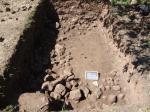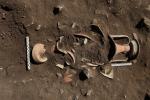Summary (English)
The continuation of excavations in area HP revealed a sequence of ill-defined Epipaleolithic-Mesolithic occupations followed by periodic, but not isolated episodes, represented by cult practices associated with the arrangement of stone circles and animal bones and several stones with linear incisions and more complex geometric decoration.
A new trench was opened (Area R), in zone E of the sanctuary. Below the initial stratigraphy characterised by modern and medieval phases there was a chronologically sealed layer. A small Egnathian style cup and a Panathenaic type Apulian black-figure amphora were found within this layer. In the immediately underlying contexts, there were four empty stone circles and one still containing the offerings: a white-painted trilobed oinochoe of Arpana production (4th-late 3rd century B.C.) and a black glaze patera, almost intact, containing a partially burnt astragalus, and an imported black bowl with random linear incisions on the surface. In addition to the pottery, numerous architectural fragments were recovered, among which a limestone element with a wave motif in low-relief. Associated with these elements, of particular interest were the fragments of a terracotta floor surface on which there were traces of opus signinum suggesting the existence of a vat. Lastly, numerous inscriptions were present on the pottery and for the first time on stone, including a fragment bearing a four-line inscription with six Greek letters and in the Messapian language (5th-4th century B.C.).South of area R, it was decided to open a new trench (area S). In the south-western part, a course of roughly-worked and squared stone blocks bonded with mortar on an E-W alignment was uncovered. Based on the pottery finds, this structure can be dated to a phase between the 12th and 14th century. In the eastern part of the trench, at c. 50 cm below ground level, a new course on a NE-SW alignment was exposed. Earlier than the first wall, it was built of large semi-worked limestone blocks and part of the later wall rested on top of it.
- Donato Coppola – Università degli Studi di Bari “Aldo Moro”
- Nicola de Pinto - Università degli Studi di Bari “Aldo Moro”
- Michele Pellegrino - Università degli Studi di Bari “Aldo Moro”
Director
- Donato Coppola – Università degli Studi di Bari “Aldo Moro”
Team
- Henry Baills - Musée de Tautavel, Centre Européen de Préhistoire
- Nicola de Pinto - Università degli Studi di Bari “Aldo Moro”
- Martine Dewailly - Ecole Française de Rome
- Michele Pellegrino - Università degli Studi di Bari “Aldo Moro”
Research Body
- Università degli Studi di Bari “Aldo Moro”
Funding Body
- Comune di Ostuni, Museo di Civiltà Preclassiche della Murgia meridionale






![Download [PDF]](/excavation/skins/fasti/images/results/download_sml.png)




